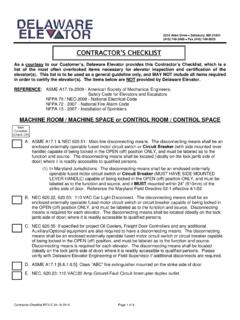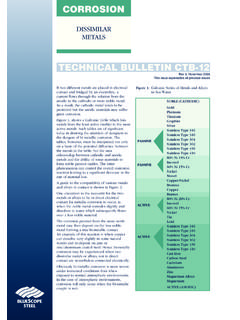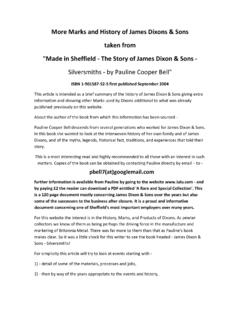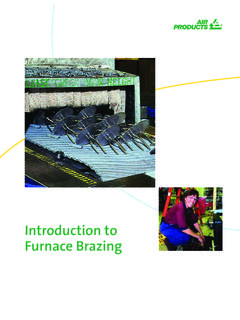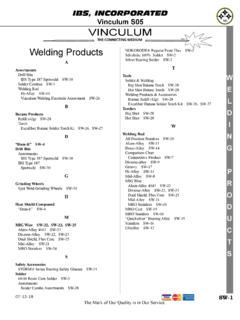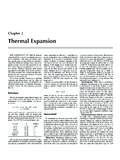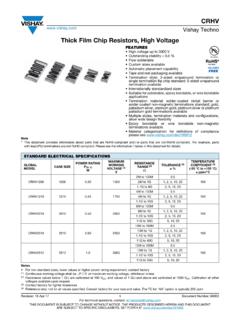Transcription of A review of Corrosion and environmental effects on …
1 A review of Corrosion and environmental effects on electronics Rajan Ambat Department of Manufacturing and Management Technical University of Denmark 2800 Kgs. Lyngby, Denmark Abstract Electronic industry uses a number of metallic materials in various forms. Also new materials and technology are introduced all the time for increased performance. In recent years, Corrosion of electronic systems has been a significant issue. Multiplicity of materials used is one reason limiting the Corrosion reliability. However, the reduced spacing between components on a printed circuit board (PCB) due to miniaturization of device is another factor that has made easy for interaction of components in corrosive environments.
2 Presently the knowledge on Corrosion issues of electronics is very limited. This paper reviews briefly the materials used in electronic systems, factors influencing Corrosion , types of Corrosion observed in electronics, and testing methods. Introduction Presently electronic devices are used under service conditions that were never thought off few years back. Simultaneously, increased use of electronics has also increased the demand for reliability. The demand for miniaturization, multiplicity of materials used, effect of process residues together with unpredictable user environment has opened up serious Corrosion problems.
3 The consumer electronics is one sector where the user environment is highly variable. Overall size of electronic equipment has also been decreasing presently at a faster rate. The size of the ICs has been decreased by a factor of 10 over the last couple of years, which means that the spacing between the IC components is ~ 200 nm. For components on a PCB, the spacing is around 5 microns, while in mid-90's it was 100 microns. The reduction in size and distance between components makes the system more susceptible to Corrosion problems. To generate a fault in the conducting path of such constructions, a material loss of the order of picograms (10-12) is sufficient [1].
4 Therefore, even a small environmental impact can cause huge damages if the components are not well protected. When the device is in use, the large voltage gradients between points on a PCB will accelerate the Corrosion problems dramatically. However, the impact of voltage gradient on PCB Corrosion is often overlooked with respect to damage in electronic circuits. Present review discuss briefly about important electronic components and parts, materials used in them, and various Corrosion issues related to materials combinations and design. A. brief discussion on the effect of various parameters and testing methods are also included.
5 Materials in electronic systems From the viewpoint of a Corrosion specialist, Corrosion in electronics is not a surprise due to the multiplicity of materials used simultaneously with several other factors conducive for Corrosion . As the materials used are many and component designs are complicated, it is beneficial for the non-electronic reader to have knowledge on these prior to the discussion on Corrosion issues. A detailed discussion on every component is beyond the scope of this view, therefore following are the important ones that experience significant Corrosion problems.
6 Integrated Circuits (ICs). Printed Circuit Board (PCB). Switches Magnetic Recording Media (Hard disc). Packaging and shielding parts Integrated Circuits (IC): An integrated circuit is basically made of silicon, although other metals such as gold, silver, copper, zinc, aluminium or their alloys are used for various purposes such as connecting leads, bumps etc. Connectors are for electrical contact between the different active elements on the silicon wafer. Figure 1 describes in detail an IC circuit and components. The silicon chip consists of semiconductors made with doping of impurities.
7 The IC elements are connected to the PCB using lead frame. The lead frames, thus, are the connection between the electronic terminals (also called bumps) of the silicon wafer and the surrounding macro- electronic (PCB) part of the circuitry. The bumps on the silicon wafer are made of gold and they are connected to the lead frames with a bonding process for electrical connection using a gold or aluminium wire. Figure 1. Integrated circuit and related components [2]. Lead frames are often made of alloys like Cu/Zn37, CuFe2, FeNi42 (alloy 42), or CuNiZn (Vacon). The end of the lead, which needs to be bonded to the wafer is selective treated with gold or silver.
8 The other end has treated with a solderable coating for connecting to the PCB. The ICs are protected by encapsulating in a polymer. Different methods are used for bonding the wire to the lead frames. These are: Ultrasonic bonding (U/S), thermo sonic bonding (T/S) and thermo compression bonding (T/C). Further, there are two ways of joining the wire to silicon chip. One process is called ball bonding and the other wedge bonding. Figure 2 shows a ball bonding of gold wire to aluminium PVD coating on silicon chip. The picture also shows how the material is compressed out of the interface area.
9 Ball bonding is possible with a lot of different materials Au/Au, Au/Ni, Au/Ag, Al/Al, and Cu/Al to name a few. Only few Corrosion cases have been reported on Ball bonded parts, although the possibility of galvanic Corrosion is over looked. However, there are other problems related to intermetallic phase formation and Kirkendall effect at the Figure 2. Picture of a ball bonded gold wire interface. to aluminium on an IC circuit Printed Circuit Board (PCB): PCB is a macro-electronic structure compared to an IC, where a number of electronic parts are integrated (including ICs) on a fibreglass epoxy polymer with interconnecting lines as shown in Figure 3c.
10 Typical PCB consists of copper connecting path integrated in a fibreglass reinforced epoxy polymer (Figure 3a). The PCB can be made of a series of layered structure (from double to multi layer) with each layer consisting of interconnecting lines (Figure 3b). The line in each layer is connected to the lines on top and bottom through blind holes, which is plated. The connection paths are made solderable with a Sn-Pb coating, which also act as an etch-resist in the manufacturing process. Recent processes for PCB wiring use ENIG-process (Electroless Nickel-Gold). The ENIG consists of a few micron thick Ni-P (EL Ni) coating on the base copper on PCB, followed by a thin gold layer on EL Ni [3].
